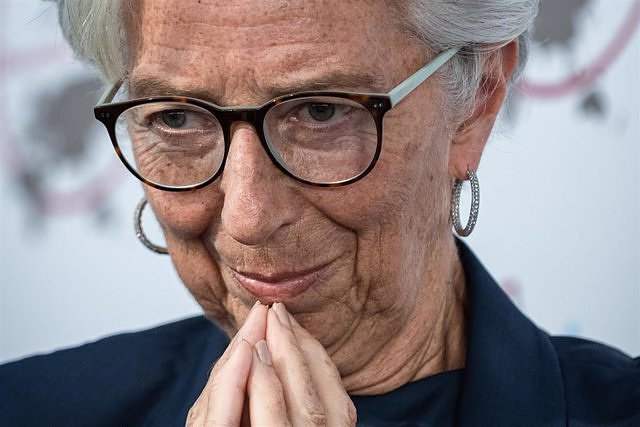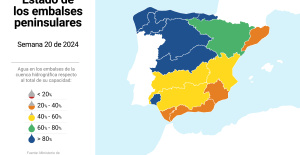The fall in the demand for credit from companies was "substantially stronger" than anticipated by banks
The demand for loans and lines of credit by companies plummeted in the second quarter to a new all-time low as a result of the rise in interest rates and the fall in investment, according to the survey of bank loans prepared by the European Central Bank (ECB), which anticipates a new drop in data in the third quarter, although less intense.
Between April and June, the net demand for loans from euro area companies decreased considerably, with a net percentage of -42%, compared to -38% in the previous quarter, implying a record low since the start of the ECB survey in 2003.
In fact, the observed fall was "substantially stronger than expected by the banks in the previous quarter," according to the study by the central bank, whose Governing Council will meet again this Thursday to determine the monetary policy of the euro zone, with a virtually certain rise of 25 basis points in interest rates.
According to the survey, the net decline in loan demand was the strongest since the start of the time series in 2003 for SMEs, while the net decline in loan demand by large firms remained slightly more limited than during the global financial crisis.
In addition, the net decline in demand was also the strongest in the study's history for long-term loans, while demand for short-term loans declined to a lesser extent, but still close to the record low recorded during the global financial crisis.
"Rising interest rates and lower fixed investment continued to be the main drivers of the net decline in loan demand," the central bank notes, adding that other factors behind the slump in demand were lower funding needs for mergers and acquisitions, available domestic funding with better corporate profits and, to a lesser extent, debt issuance.
In any case, the ECB highlights that, for both SMEs and large companies, the general level of interest rates and the lower financing needs of companies for fixed investment were the main drivers of the reduction in the demand for loans in the quarter.
By country, the study finds that the drop in demand for business loans reached considerable levels in the four largest economies in the euro zone.
In line with the euro area aggregate, higher interest rates and lower financing needs for fixed investment were the main drivers of this reduction in loan demand in all four countries.
Looking ahead to the third quarter of the year, euro area banks expect a further net decline in the demand for business loans, but much less than in the second quarter.
However, the ECB notes that, since the end of 2022, banks have tended to have "overly positive" expectations for loan demand, suggesting that expectations for the third quarter could also be overly optimistic.
In this sense, the entities expect the rate of decline in credit demand to be less intense for both short-term and long-term credit demand in the third quarter.
DEMAND FOR MORTGAGES.
On the other hand, in the second quarter, Eurozone banks also reported a sharp net decline in demand for loans for house purchase, which, however, was less than the net decline observed in the previous two quarters.
In this sense, the main causes indicated for the weakening of the demand for mortgages were the higher interest rates, the weakening of the outlook for the housing market and low consumer confidence.
Demand for housing loans declined substantially in the four largest euro area countries due to the impact of interest rates and the housing market outlook. Among these factors, rising interest rates had the biggest cushioning impact across all countries, while the negative outlook for the housing market weighed more heavily on France than on Germany, Spain and Italy.
Likewise, the ECB survey confirms a net decrease in the demand for consumer credit and other loans to households, driven mainly by the increase in interest rates and low consumer confidence.
Looking ahead to the next quarter, surveyed banks expect a further, albeit notably less pronounced, net decline in demand for housing loans, and a somewhat smaller net decline in demand for consumer credit.
LOAN CONDITIONS.
From the supply side, according to the survey on bank loans in the euro area, credit standards for loans or lines of credit to companies tightened further in the second quarter of 2023, although less intensely than in the first quarter of the year and in line with what banks expected.
"The cumulative net tightening since the beginning of 2022 has been substantial, and the survey results have provided early indications of the significant weakening in credit dynamics observed since last fall," the ECB highlights.
Likewise, the entities also reported an additional net tightening of their credit standards for loans to households for house purchase, as well as consumer credit and other loans to households.
However, the recorded net tightening was less pronounced than in the previous quarter for housing loans, while it was more pronounced for consumer credit.
In this sense, banks pointed to higher risk perceptions related to the economic outlook and the specific situation of the borrower, lower risk tolerance and higher cost of funds as the main reasons for tightening standards.
By the third quarter of 2023, euro area banks expect a further, albeit more moderate, net tightening of credit standards for corporate lending, while they anticipate unchanged credit standards for lending to households for house purchase.
In the case of consumer credit, Eurozone banks expect a minor net tightening of credit standards.

 Exploring Cardano: Inner Workings and Advantages of this Cryptocurrency
Exploring Cardano: Inner Workings and Advantages of this Cryptocurrency Seville.- Economy.- Innova.- STSA inaugurates its new painting and sealing hangar in San Pablo, for 18 million
Seville.- Economy.- Innova.- STSA inaugurates its new painting and sealing hangar in San Pablo, for 18 million Innova.- More than 300 volunteers join the Andalucía Compromiso Digital network in one month to facilitate access to ICT
Innova.- More than 300 volunteers join the Andalucía Compromiso Digital network in one month to facilitate access to ICT Innova.-AMP.- Ayesa acquires 51% of Sadiel, which will create new technological engineering products and expand markets
Innova.-AMP.- Ayesa acquires 51% of Sadiel, which will create new technological engineering products and expand markets Putin begins his fifth term demanding the "security" and "unity" of Russia
Putin begins his fifth term demanding the "security" and "unity" of Russia Almeida points to the death of two workers after being trapped under an 8-ton slab in Madrid
Almeida points to the death of two workers after being trapped under an 8-ton slab in Madrid Armengol and two former senior officials from the Balearic Islands, summoned by the Congressional commission on masks
Armengol and two former senior officials from the Balearic Islands, summoned by the Congressional commission on masks Puente assures that if he had known the impact of his words on Milei he would not have said them
Puente assures that if he had known the impact of his words on Milei he would not have said them How Blockchain in being used to shape the future
How Blockchain in being used to shape the future Not just BTC and ETH: Here Are Some More Interesting Coins Worth Focusing on
Not just BTC and ETH: Here Are Some More Interesting Coins Worth Focusing on They develop devices for the precise diagnosis of cancer patients
They develop devices for the precise diagnosis of cancer patients UMH researchers are working on a high-quality apricot crop that requires less irrigation water
UMH researchers are working on a high-quality apricot crop that requires less irrigation water The UPV develops an application to improve the quality of life of patients with glioblastoma
The UPV develops an application to improve the quality of life of patients with glioblastoma A sensor system obtains the fingerprint of essential oils and detects if they have been adulterated
A sensor system obtains the fingerprint of essential oils and detects if they have been adulterated A million people demonstrate in France against Macron's pension reform
A million people demonstrate in France against Macron's pension reform Russia launches several missiles against "critical infrastructure" in the city of Zaporizhia
Russia launches several missiles against "critical infrastructure" in the city of Zaporizhia A "procession" remembers the dead of the Calabria shipwreck as bodies continue to wash up on the shore
A "procession" remembers the dead of the Calabria shipwreck as bodies continue to wash up on the shore Prison sentences handed down for three prominent Hong Kong pro-democracy activists
Prison sentences handed down for three prominent Hong Kong pro-democracy activists ETH continues to leave trading platforms, Ethereum balance on exchanges lowest in 3 years
ETH continues to leave trading platforms, Ethereum balance on exchanges lowest in 3 years Investors invest $450 million in Consensys, Ethereum incubator now valued at $7 billion
Investors invest $450 million in Consensys, Ethereum incubator now valued at $7 billion Alchemy Integrates Ethereum L2 Product Starknet to Enhance Web3 Scalability at a Price 100x Lower Than L1 Fees
Alchemy Integrates Ethereum L2 Product Starknet to Enhance Web3 Scalability at a Price 100x Lower Than L1 Fees Mining Report: Bitcoin's Electricity Consumption Declines by 25% in Q1 2022
Mining Report: Bitcoin's Electricity Consumption Declines by 25% in Q1 2022 Oil-to-Bitcoin Mining Firm Crusoe Energy Systems Raised $505 Million
Oil-to-Bitcoin Mining Firm Crusoe Energy Systems Raised $505 Million Microbt reveals the latest Bitcoin mining rigs -- Machines produce up to 126 TH/s with custom 5nm chip design
Microbt reveals the latest Bitcoin mining rigs -- Machines produce up to 126 TH/s with custom 5nm chip design Bitcoin's Mining Difficulty Hits a Lifetime High, With More Than 90% of BTC Supply Issued
Bitcoin's Mining Difficulty Hits a Lifetime High, With More Than 90% of BTC Supply Issued The Biggest Movers are Near, EOS, and RUNE during Friday's Selloff
The Biggest Movers are Near, EOS, and RUNE during Friday's Selloff Global Markets Spooked by a Hawkish Fed and Covid, Stocks and Crypto Gain After Musk Buys Twitter
Global Markets Spooked by a Hawkish Fed and Covid, Stocks and Crypto Gain After Musk Buys Twitter Bitso to offset carbon emissions from the Trading Platform's ERC20, ETH, and BTC Transactions
Bitso to offset carbon emissions from the Trading Platform's ERC20, ETH, and BTC Transactions Draftkings Announces 2022 College Hoops NFT Selection for March Madness
Draftkings Announces 2022 College Hoops NFT Selection for March Madness
























